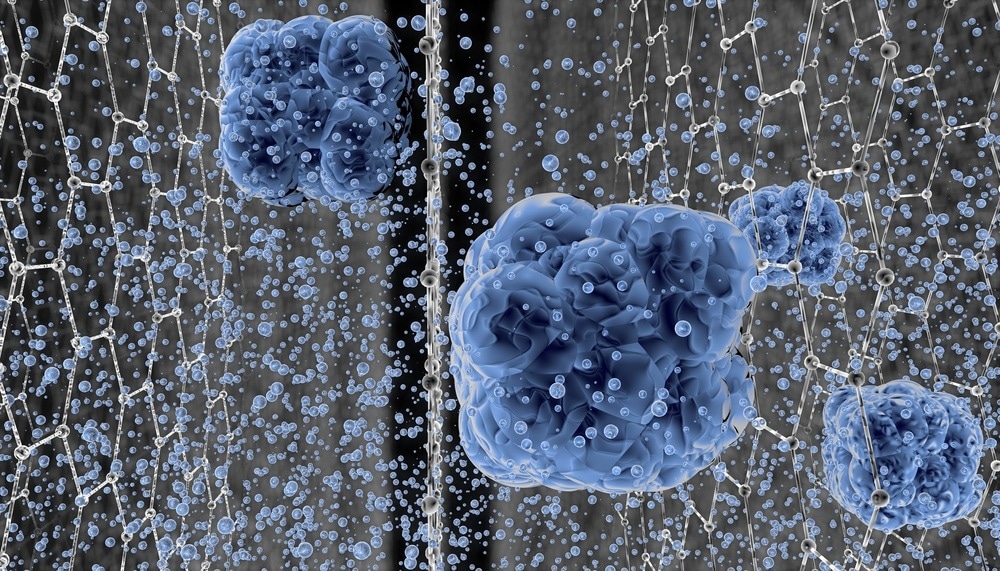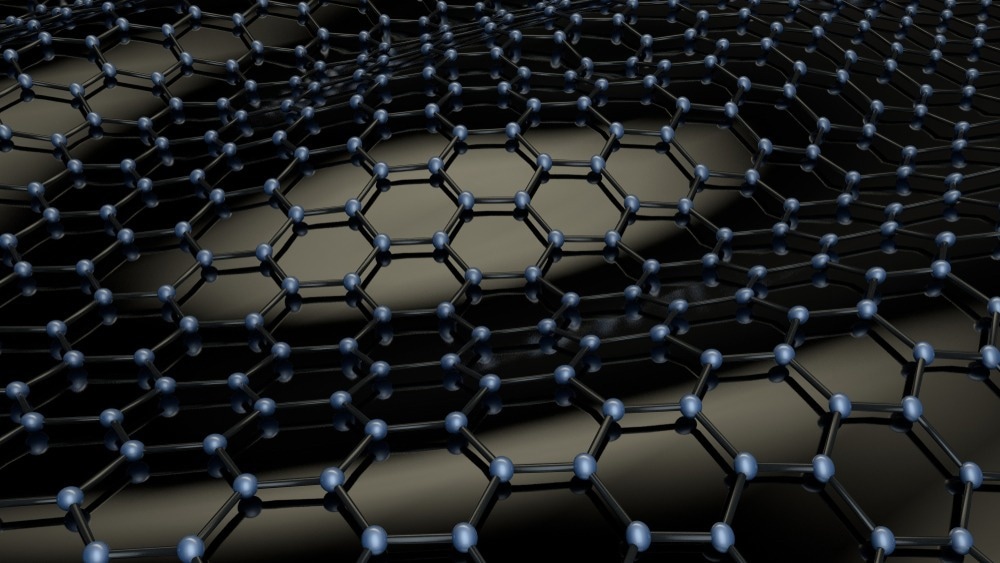Overpopulation and rapid industrialization have led to water scarcity worldwide. Seawater and wastewater have been considered to be potential sources for producing fresh water.

Image Credit: Angel Soler Gollonet/Shutterstock.com
Compared to conventional methods, membrane-based separation methods have been found to be more desirable for water treatment. Recently, two-dimensional (2D) nanomaterials have been used to create high-performance molecular separation membranes, which are even more efficient than existing methods.
Conventional vs. Membrane-Based Separating Strategies
Conventional water treatment methods, such as distillation, electrochemical treatment, thermal desalination, and adsorption, have several drawbacks. In contrast, the membrane-based separation process has been found to be more promising with several advantages, including low energy consumption, small carbon footprint, continuous operation mode, and eco-friendly characteristics.
Membranes for a particular use are chosen based on their selectivity and permeability. Selectivity is associated with separating the target molecules and permeability determines how fast molecules can pass through a membrane material.
One of the limitations of conventional membrane materials is that the functioning of the membrane cannot be changed as per requirement. An ideal membrane material should be thin, have high permeability, narrow pore size distribution, and be mechanically, chemically, and thermally robust. These properties enable efficient separation and long service life.
Several 2D nanomaterials, such as graphene (and its derivatives), metal-organic frameworks (MOFs), layered transition metal dichalcogenides (TMDCs), and covalent organic frameworks (COFs), have been used to create advanced membrane materials. More recently, a 2D transition metal carbide and/or nitride (MXene) nanosheet has been used to develop high-performance molecular separation membranes.
Compared to conventional membranes, which are made up of polymeric and inorganic materials, 2D nanomaterials with unique mono-atomic thickness can be used to develop an ultrathin membrane-separating layer. This is beneficial because of minimal transport resistance and high permeation flux, essential for maximum separation capability.
Development and Working Mechanism of 2D Nanomaterial Membranes
2D nanomaterial-based membranes can be either porous or non-porous based on their atomic structure. Two forms of membranes, i.e., nanosheet and laminar membranes, are formed using this nanomaterial.
Nanosheets typically consist of a single or few layers of 2D nanomaterials with precise nanopores (e.g., MOFs and COFs) or specific perforation (e.g., graphene) for selective permeation. However, laminar membranes are formed by the controlled assembly of 2D nanomaterial nanosheets, such as graphene oxide (GO), into layered stacks presenting interlayer channels. These channels are used to transport molecules/ions.
Nanopores can be introduced on a single-layer 2D nanosheet through various techniques, including electron beam irradiation, oxidation etching, ion beam bombardment, and plasma etching.
Uniform interlayer spacing can be achieved through the stacking of 2D flakes of similar sizes that contain similar ions/molecules. Insertion of nanomaterials into the interlayer of the 2D membranes can increase the stacking distance of the laminates, which enhances the permeability.
Basically, two mechanisms are associated with the separation and interception of 2D nanomaterial membranes, founded on the separation principle based on size differences and the electrostatic interaction/Donnan effect. The first mechanism is associated with the size of the nanopore, such that it can exclude molecules larger than the membrane pore size.
The second mechanism is linked with pore-chemistry-induced electrostatic repulsion. In this case, the surface of the 2D nanomaterials-based membranes is negatively charged, which inhibits the passing of negatively charged molecules/ions, and, consequently, allows migration of positively charged molecules/ions through electrostatic interactions.
The functional groups present on the surfaces of 2D nanomaterials also play an important role in molecular/ionic separations. These functional groups can selectively interact with sample molecules and either facilitate or hinder permeation. Therefore, selectively stacked 2D nanomaterial-based membranes can also promote the adsorption of ionic species to the 2D material flakes via cation π, electrostatic binding, and metal coordination.
The precise tuning of nanopore structure and spacing, and optimization of surface functionalities, can improve membrane efficacy based on permeance and selectivity.

Image Credit: 3DStach/Shutterstock.com
Types of 2D Nanomaterial-Based Membranes
The different types of 2D nanomaterial-based membranes are discussed below:
2D Nanosheet Membranes
Some of the common 2D porous nanosheet membranes include MOFs and COFs, or those formed by drilling pores into graphene sheet-like materials. Membrane thickness and pore structure determine the membrane’s selectivity and permeation flux.
MOFs belong to the family of porous crystalline materials, which are composed of inorganic metal ions. These are also made up of metal clusters connected by organic ligands via coordination bonds. MOF-based membranes are considered to be potent candidates for liquid separation.
Typically, 2D MOF nanosheets are synthesized via two methods, i.e., top-down and bottom-up methods.
The top-down method is used to develop an ultrathin monolayer of 2D Zinc-MOF nanosheet that contains extra-large lateral dimensions, whereas the bottom-down method is used to develop zeolitic imidazolate framework-67 (ZIF-67) nanosheets. Graphene membranes are considered to be potent candidates for next-generation liquid separation systems.
2D Lamellar Membranes
2D layered stacks have been considered to be high-performance membranes. The stacking and arranging of GO nanosheets into a layered membrane has been recognized as a cost-effective water treatment strategy. Particularly, oxygen-containing functional groups of graphene oxide provide additional functionalization to improve membrane properties associated with specific interactions with ions and molecules. Persistent interlayer hydrogen bonds connect the GO sheets and form a stable membrane.
Several strategies are used to develop graphene-based 2D lamellar membranes, including drop casting, layer-by-layer (LBL) assembly, dip coating, and spray coating. Each of these techniques comes with some advantages and disadvantages. For instance, the drop-casting technique has been associated with developing uneven membranes with variable thickness and internal structure. However, this drawback has been overcome by the LBL strategy that offers a controlled deposition cycle.
For selective permeability, GO nanosheet membranes are regulated by three transport channels, i.e., slit-like pores formed by edge-to-edge nanosheet interactions, interlayer channels formed by face-to-face nanosheet interactions, and structural modifications. Under dry conditions, GO-based membranes repel liquid and gas molecules and only permit water molecules.
Reduced graphene oxide (rGO) membranes containing lower oxygen functional groups have exhibited greater sieving ability due to their narrower nanochannels, enhanced stability in water, and lower swelling.
References and Further Reading
Zang, H. et al. (2022) A Review of Advancing Two-Dimensional Material Membranes for Ultrafast and Highly Selective Liquid Separation. Nanomaterials, 12, p. 2103. doi.org/10.3390/nano12122103
Othman, Z. and Mahmoud, K.A. (2021) Advancements of 2D Materials-Based Membranes. Membranes (Basel). 12(1), p. 52. doi: doi.org/10.3390/membranes12010052.
Chowdury, I. (2020) Two-Dimensional Nanostructure based Membranes for Water Filtration Webinar. Available at: https://fount.aucegypt.edu/audiovisual_faculty_work/9
Zhang, J. et al. (2019) Two dimensional nanomaterial-based separation membranes. Electrophoresis. 40(16-17), pp. 2029-2040. doi.org/10.1002/elps.201800529.
Zhu, J. et al. (2018) The rapid emergence of two-dimensional nanomaterials for high-performance separation membranes. Journal of Material Chemistry A, 6, pp. 3773-3792. doi.org/10.1039/C7TA10814A
Jin, H. et al. (2016) Highly stable and self-repairing membrane-mimetic 2D nanomaterials assembled from lipid-like peptoids. Nature Communications, 7, p. 12252. doi.org/10.1038/ncomms12252
Disclaimer: The views expressed here are those of the author expressed in their private capacity and do not necessarily represent the views of AZoM.com Limited T/A AZoNetwork the owner and operator of this website. This disclaimer forms part of the Terms and conditions of use of this website.